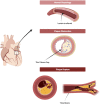Posing the rationale for synthetic lipoxin mimetics as an adjuvant treatment to gold standard atherosclerosis therapies
- PMID: 36865918
- PMCID: PMC9971729
- DOI: 10.3389/fphar.2023.1125858
Posing the rationale for synthetic lipoxin mimetics as an adjuvant treatment to gold standard atherosclerosis therapies
Abstract
Atherosclerosis is a progressive, multifactorial inflammatory, and dyslipidaemic disease, responsible for the majority of cardiovascular diseases globally. The chronic inflammation is the main driver of the initiation and progression of such disease, as a result of an imbalanced lipid metabolism and an ineffective immune response to attenuate the inflammatory component. The importance of inflammation resolution is being increasingly recognised in atherosclerosis and cardiovascular disease. It has a complex mechanism consisting of multiple stages, including restoring an effective removal of apoptotic bodies (efferocytosis) and their degradation (effero-metabolism), a macrophage phenotype switching towards resolving phenotypes, and the promotion of tissue healing and regeneration. The low-grade inflammation associated with atherosclerosis development is a driving force in disease exacerbation, and hence inflammation resolution is a key area of research. In this review, we explore the complex disease pathogenesis and its many contributing factors to gain a greater understanding of the disease and identify the current and potential therapeutic targets. First-line treatments and their efficacy will also be discussed in detail, to highlight the emerging field of resolution pharmacology. Despite the great efforts made by current gold-standard treatments, such as lipid-lowering and glucose-lowering drugs, they remain ineffective at tackling residual inflammatory risk and residual cholesterol risk. Resolution pharmacology represents a new era of atherosclerosis therapy, as endogenous ligands associated with inflammation resolution are exploited for their pharmacological benefits in a more potent and longer-acting manner. Novel FPR2-agonists, such as synthetic lipoxin analogues, provide an exciting new approach to enhance the pro-resolving response of the immune system and subsequently end the pro-inflammatory response to allow for an anti-inflammatory and pro-resolving environment for tissue healing, regeneration, and return to homeostasis.
Keywords: FPR2; cardiovascular disease; efferocytosis; glucose-lowering drugs; lipid-lowering drugs; resolution pharmacology; synthetic lipoxin mimetics.
Copyright © 2023 Millar and de Gaetano.
Conflict of interest statement
The authors declare that the research was conducted in the absence of any commercial or financial relationships that could be construed as a potential conflict of interest.
Figures



References
Publication types
LinkOut - more resources
Full Text Sources

